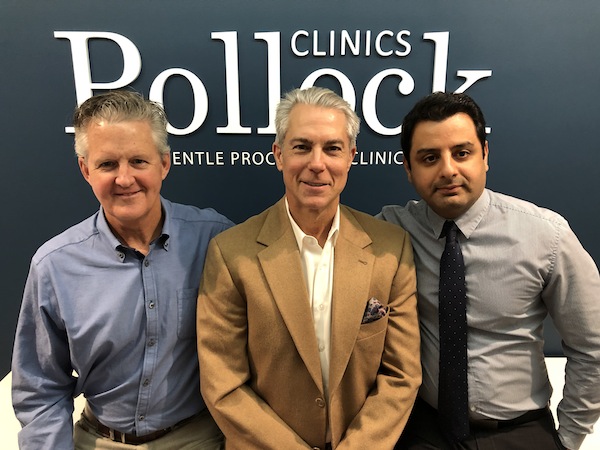Left to right: Pollock Clinics sex therapist Tom Foster and physicians Neil Pollock and Roozbeh Ahmadi. (photo from Pollock Clinics)
While there may be any number of reasons why the frequency of a couple’s intimate sexual contact may wane, it is a critical cornerstone supporting the continuation of a healthy relationship. Often, when a couple is having sex infrequently, or not at all, their relationship becomes vulnerable to anger, detachment, infidelity and divorce. One factor that can come into play regarding a couple and their sex life is erectile dysfunction.
“ED is a medical condition where a man is consistently unable to achieve and maintain an erection that allows for satisfactory sexual function. ED is also referred to as impotence,” explained Drs. Neil Pollock and Roozbeh Ahmadi of Pollock Clinics in an email interview with the Independent. “The Canadian Study of Erectile Dysfunction identified 49.4% of men over the age of 40 with ED (Canadian Urological Association erectile dysfunction guideline 2015). By the time men reach the age of 70, almost 70% of them will experience some form of erectile dysfunction.”
Conventional treatment for ED generally involves blocking the symptoms, with medications like Viagra and Cialis. “If pills are not working, the next step is the injection or suppository forms of medications that patients can inject into the penis or infuse into the urethra prior to having intercourse,” said the doctors. “If these medications are not satisfactory, then there is the option of a vacuum erection device that a patient will need to apply to the penis and get an erection through the vacuum created within the tube. If none of the options is satisfactory, then there is the option of surgery, such as penile implant surgery.
“The issue with pills, injection and pump is the fact that all need prior timing and preparation and, in the case of pills, they can cause significant side effects, such as headaches, flushing, upset stomach and visual changes, which a lot of patients cannot tolerate.”
There are many factors that can cause ED. “These include neurological disorders, hormonal imbalance, structural abnormalities, side effects of medications or surgeries, mood disorders,” said the doctors, but “the most important and prevalent one is vascular disease.
“When a man becomes aroused, the brain releases a neurochemical substance to increase the size of blood vessels carrying blood to the penis and reduce the size of the vessels that carry it out,” they explained. “Twin compartments that run the length of the penis, called corpora cavernosa, become flush with blood that is trapped in the shaft. This causes the penis to stiffen and become erect. If blood flow to the penis is inhibited or the blood vessels are clogged or constricted, erection cannot be achieved or maintained.”
High cholesterol and the buildup of arterial plaque, over time, cause blood vessels to narrow, lessening their capability to carry blood. One of the first places men will notice this reduced flow is with ED, which is why ED has been dubbed “the canary in the coal mine” – it can serve as a distress signal three to five years prior to a major heart attack.
Lifestyle choices and health conditions that can also contribute to ED include smoking, obesity, a sedentary lifestyle and chronic alcoholism and/or substance abuse.
“Sexual wellness is essential to men’s health and happiness,” said Pollock and Ahmadi. “It is an integral part of men’s overall wellness as they age. A great number of scientific studies have shown the many benefits of a healthy and active love life, which include living longer, greater well-being and a happier and longer lasting relationship with your partner.”
Pollock Clinics provides a few treatments for ED.
“In the last few years, there are innovative regenerative treatment options to deal with the root cause of the problem, and not just the symptom,” said the doctors. “These new modalities include low-intensity shockwave therapy and platelet-rich plasma therapy [also known as the PRP shot], and are currently used in many countries around the world.”
PRP is created from a patient’s own blood and is commonly used in orthopedics, plastic surgery and sports medicine. “Studies have shown that this penile injection contains several different growth factors that can stimulate the healing of erectile tissue and is a safe and effective option for penile rejuvenation and improvement of erectile function … by enhancing and increasing the blood flow to the erectile tissue, offering a longer lasting desired outcome.
“ED shockwave therapy,” the doctors explained, “also promotes the regeneration of blood vessels in the penile shaft. That, like PRP, leads to longer and more satisfying erections and is accomplished by directing painless energy waves into the shaft of the penis.”
In addition to these two treatments, Pollock Clinics offers therapy, since ED has both physiological and psychological causes.
“Pollock Clinics also has a certified sex therapist to deal with psychogenic issues that might be affecting a man’s sexual health,” said the doctors. The goal of therapy is to provide “strategies to get a patient’s mind working with him instead of against him in a sexual encounter.”
Pollock and Ahmadi strongly encourage men to talk to their own doctor about any health issues they may have and the treatment options available.
Rebeca Kuropatwa is a Winnipeg freelance writer.

